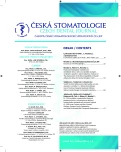-
Medical journals
- Career
Comparison of Mono-Layer and Two-Layers Phantom Teeth Used in Preclinical Courses
Authors: I. Voborná; K. Foukalová; K. Francová
Authors‘ workplace: Klinika zubního lékařství LF UP a FN, Olomouc
Published in: Česká stomatologie / Praktické zubní lékařství, ročník 114, 2014, 3, s. 43-48
Category: Original Article – Experimental Study
Overview
Introduction and aim of study:
Preclinical practical exercises are an important part of teaching dentistry. It takes place on the phantom simulators, jaws and teeth in the adapted phantom labs. The aim of this experimental study was to assess the contribution of two-layer phantom teeth with carious lesions for teaching preclinical dentistry compared to mono-layer teeth without carious lesions.Material and methods:
The study consisted of two parts – the questionnaire and a practical part. Questionnaires were surveyed students‘ opinions on various properties of mono-layer teeth without carious lesions (KaVo) with a two-layers tooth with carious lesions (Nissin). In the practical part the selected parameters of cavities were compared on both types of teeth.Results:
100 questionnaires were completed by all first-year students. Students were more satisfied with the two-layer teeth with carious lesions. Practical part were done by 88 first-year students. Each student made two fillings II. class according to Black, one on the mono-layer tooth and the second on the two-layers tooth. Some cavity parameters were better on two-layer teeth. Two-layer teeth with carious lesions were beneficial for preclinical practical exercises.Conclusion:
Preclinical instruction and practical exercises on the phantom simulator and phantom teeth as most similar human jaw teeth are an important part of dental studies. Spatial orientation in dental tissues is an essential part of teaching. Experimental studies have shown that students are able to do better preparation on the two-layers teeth with carious lesions. These teeth also students in the questionnaire evaluated as more acceptable and suitable for preclinical teaching. The authors have same opinion.Key words:
education – phantom teeth – phantom models – two-layers phantom teeth
Sources
1. He, L. H., Foster Page, L., Purton, D.: An evaluation of dental operative simulation materials. Dental Materials J., roč. 31, 2012, č. 4, s. 645–649.
2. Harvan, Ľ., Stejskalová, J.: Hodnocení přínosu využití moderních vyučovacích metod v zubním lékařství na Lékařské fakultě Univerzity Palackého v Olomouci z pohledu pedagogů. Čes. Stomat., roč. 112, 2012, č. 4, s. 107–114.
3. Almasoud, N., Bearn, D.: Little‘s irregularity index: Photographic assessment vs study model assessment. American journal of orthodontics and dentofacial orthopedics : official publication of the American Association of Orthodontists, its constituent societies, and the American Board of Orthodontics, roč. 138, 2010, č. 6, s. 787–794.
4. Hellwig, E., Klimek, J., Attin, T.: Záchovná stomatologie a parodontologie. Praha, Grada Publishing, 2003, ISBN 80-247-0311-4.
5. Mitchell, L., Mitchell, D. A., McCaul, L.: Oxford handbook of clinical dentistry, 5th ed. Oxford University Press, 2011, ISBN 978-0-19-955330-3.
6. Stejskalová, J.: Konzervační zubní lékařství. Praha, Galén, 2003, ISBN 80-7262-225-0.
Labels
Maxillofacial surgery Orthodontics Dental medicine
Article was published inCzech Dental Journal

2014 Issue 3-
All articles in this issue
- The Assessment of the Biocompatibility of Dental Alloys and Alloys for Dental Amalgam. Part First
- Use of Factory-Prepared Equimolar Mixture Nitrous Oxide/Oxygen in Paediatric Dentistry
- Er: YAG Laser Contact and Non-Contact Delivery Systems Cavity Preparation and Sonic-Activated Bulk Composite Restoration
- The Incidence of Agenesis of Third Molars in Children in the Olomouc Region
- Comparison of Mono-Layer and Two-Layers Phantom Teeth Used in Preclinical Courses
- Czech Dental Journal
- Journal archive
- Current issue
- Online only
- About the journal
Most read in this issue- Use of Factory-Prepared Equimolar Mixture Nitrous Oxide/Oxygen in Paediatric Dentistry
- Comparison of Mono-Layer and Two-Layers Phantom Teeth Used in Preclinical Courses
- The Assessment of the Biocompatibility of Dental Alloys and Alloys for Dental Amalgam. Part First
- Er: YAG Laser Contact and Non-Contact Delivery Systems Cavity Preparation and Sonic-Activated Bulk Composite Restoration
Login#ADS_BOTTOM_SCRIPTS#Forgotten passwordEnter the email address that you registered with. We will send you instructions on how to set a new password.
- Career

